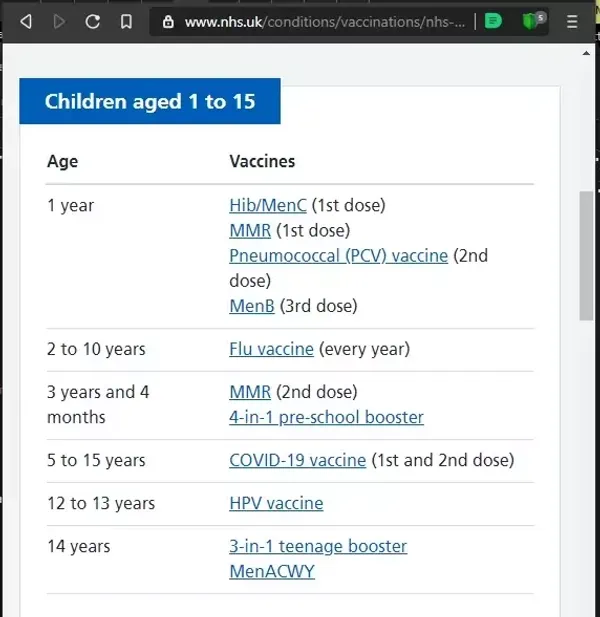Childhood vaccinations: What is going on?
Published : Tuesday 5 July 2022
Many people already feel there is something amiss, whether they intuited it or looked at the primary evidence doesn't really matter ...

This article should not be considered health advice. It is provided from a lay persons perspective "as is". Please do your own research and if concerned about your health speak to a qualified professional.
During the pandemic when we were “following the science”, several things have perplexed me as they did not align with the actual science. Whether politically, commercially or incompetence driven, it struck me as odd how some of these things got ushered through while others were ignored.
Before going any further, I should say that I am “health enthusiast” and sometimes a patient. I like to be fully informed before making decisions. This does lead me to ask a lot of questions, some of which relate to data and medical issues, others are more philosophical and existential, which is how this blog came to be. When admitted to hospital, I am the sort of person who favors more conservative and less invasive measures. That’s just who I am, but you should always do your own research and what is right for you and your family.
In recent weeks I became aware that Covid19 had been added to the routine childhood vaccination schedule in England UK, which I thought was strange given previous comments by the JVCI (Joint Committee on Vaccination and Immunisation) and what we currently know about risks and benefits.

(Click for full resolution)
When it comes to children and young people, it is our duty to proceed with the utmost caution, as they are our future and hopefully have their whole lives ahead of them. We should avoid exposing them to any unnecessary harm or risk, especially where there is little to no benefit from doing so.
Confusing and inconsistent official statements
In September of 2021 the UK’s JVCI issued a statement stating “Substantial uncertainty remains regarding the health risks associated with these adverse events. Overall, the committee is of the opinion that the benefits from vaccination are marginally greater than the potential known harms but acknowledges that there is considerable uncertainty regarding the magnitude of the potential harms.”
It’s interesting how this is stated and the way in which the numbers are presented, it feels like what needs to be understood is being obfuscated. Exactly how marginal for an individual of a given age, sex and health status?
Then, in December of 2021, Pfizer was approved for 5 to 11 year old’s, but information dated May 2022 says “COVID-19 mRNA Vaccine BNT162b2 is not recommended for children under 12 years”. Perhaps I’m missing something, but this seems to conflict.
- https://www.gov.uk/government/news/uk-regulator-approves-use-of-pfizerbiontech-vaccine-in-5-to-11-year-olds
- https://www.gov.uk/government/publications/regulatory-approval-of-pfizer-biontech-vaccine-for-covid-19/information-for-uk-recipients-on-pfizerbiontech-covid-19-vaccine
When it comes to information on the vaccine schedule itself it says “The independent Medicines and Healthcare products Regulatory Agency (MHRA) has confirmed the Pfizer/BioNTech vaccine is very effective for children aged 5 to 15.”
Another step change from what was said previously. Also, exactly how “independent” the MHRA is given their external funding sources, is an interesting question in its own right.
How did it get from “benefits from vaccination are marginally greater than the potential known harms” to “very effective”, especially given we know more recent variants are milder, and the vaccine is less effective against them? More on this to follow.
At best this is confusing and inconsistent as it lacks proper explanation.
Risk vs benefit
Historically, based on data from Oxford University, a healthy 20 year old had about a 0.0002% (2 per million) risk of catching and dying “from covid” over a 90 day period. This has since gone down.
As a side point, I have often wondered how accurate these data are given the dying “with” or “from” issue, as well as the extent to which they capture pre-existing problems properly. In particular obesity and other health deficiencies. It seems NHS and coroner records may be less than adequate.

(Click for full resolution)
Since the JVCI statements we have seen a number of variants, including Omicron, which have been milder than previous variants in 2020 and 2021.
We also know the efficacy of the jabs have not reached the levels hoped for, and this is particularly true when it comes to the more recent Omicron, for which neutralizing antibodies were found to be from 6 to 20 times less, with “substantial escape”.
- Neutralization Escape by SARS-CoV-2 Omicron Subvariants BA.2.12.1, BA.4, and BA.5 https://www.nejm.org/doi/full/10.1056/NEJMc2206576
Given the current variants are significantly milder and antibodies against them are lower, it seems critical to understand what this means for the “marginal” benefit, in particular as the risks associated with the jabs remain and are not insignificant.
Not withstanding the earlier point about escape, it is also worth noting that according to ONS, 82% of primary school children already have anti-bodies, comprised of 0.4% who were vaccinated and 81.6% who were unvaccinated."
A pervasive problem
It’s not the first time the problem of conveying efficacy has been highlighted. In February of 2021 a paper was published highlighting the mis-representation of outcome data for mRNA jabs, stating that “Reporting bias mislead and distort the public’s interpretation of COVID-19 mRNA vaccine efficacy and violate the ethical and legal obligations of informed consent”.
- Outcome Reporting Bias in COVID-19 mRNA Vaccine Clinical Trials https://www.ncbi.nlm.nih.gov/pmc/articles/PMC7996517/
There have also been numerous examples of risk data not been properly conferred. A Lancet paper in February of 2021 drew attention to the fact that the public were not being given the correct information about the risks associated with Bell’s Palsy.
- Bell’s palsy and SARS-CoV-2 vaccines https://www.thelancet.com/journals/laninf/article/PIIS1473-3099(21)00076-1/fulltext
Similarly, with myocarditis authorities seem to have under played the risks compared to what real world data has been telling us. In fact, it is often the case they are dismissed as “extremely rare” without context.
- Risk of myopericarditis following COVID-19 mRNA vaccination in a large integrated health system: A comparison of completeness and timeliness of two methods https://onlinelibrary.wiley.com/doi/10.1002/pds.5439
This is not the limit of such reports, but a few examples to illustrate a point.
Given where we are with the vaccine schedule, it would appear such issues have not been thoroughly addressed.
Discussion
To be clear, this is just me seeking clarity and exploring my thoughts in a blog. It is hard to discern the real benefit versus risk owing to mixed messages and a lack of data, but I cannot be the only one who is perplexed.
I understand that politically it may be prudent to offer parents and young people a choice, but this needs to be an explicit and informed choice, especially when dealing with children.
There appear to be a number of salient points:
- Official information has been inconsistent.
- The risk posed by Covid19 to healthy younger people has always been lower compared to other groups.
- The benefit from the jab was described as marginally greater than known risks in 2021.
- There remains uncertainty regarding the potential harm.
- The current variants of covid have been significantly milder than previous variants.
- The antibodies from the jabs against recent variants is 6 to 20 times lower.
- 82% of primary school children already have anti-bodies.
- Risks from the jabs remain, and too often have been understated.
- There is still plenty of data that has not been released to the public, including the original trial data, a very significant concern in its own right.
Given the information available, it is concerning to me that Covid19 has found its way on to the “routine schedule” and I see two key risk with this policy decision :
Blanket policies which fail to stratify risk vs benefit by age, sex and health status, will inevitably lead to avoidable harm.
Perhaps more worryingly, any perception of haste, pushing an agenda, never-mind the reality of the data or worse still the realization of harm, will erode trust in the existing vaccine schedule.
Many people already feel there is something amiss, whether they intuited it or looked at the primary evidence doesn’t really matter. I’ve long said that (real) anti-vaxxers aren’t created by other other anti-vaxxers. They are created by governments, health services and the media - Failure to address scandals, overselling their agenda, lack of transparency, misrepresenting data and failing to adequately address concerns, all lead to distrust.
Worse still, it seems in this day and age even a “fully vaccinated” individual can be dismissed as an “anti-vaxxer” if they question the media narrative, official policy or discuss their own experiences.
This is blatant gas-lighting and raises red flags for many people.

(Click for full resolution)
Conclusion
It’s quite hard to draw a general conclusion, at best I could tell you what I intuited from all this, I am certainly confused.
From talking to people, it seems to raise more questions than it answers. For example:
- Was Covid19 added to the schedule with legitimate clinical need?
- Has misrepresentation and fear of gas-lighting allowed this to slide through?
- If so what are the real motivations of those in authority?
- What does this that say about the rest of the schedule?
- Who can we really trust at this point, especially when it comes to children?
You get the idea and really this leads me to my point :
Regardless of the science, with such matters, a lack of transparency and clarity, coupled with a hostile environment makes it difficult to discern the facts. However, one thing is for certain, once trust has been eroded, it will be very hard to win it back.
Dan's Blog
Information Technology, programming, health, fitness and photography enthusiast.
- Not a writer.
- All views are my own.
- Offence is optional.
- Do your own research.